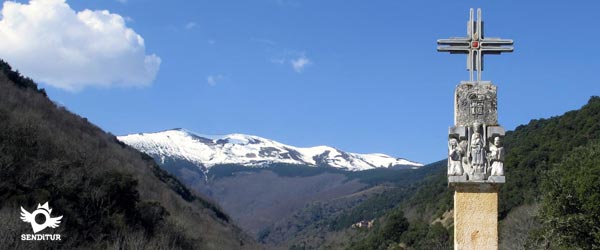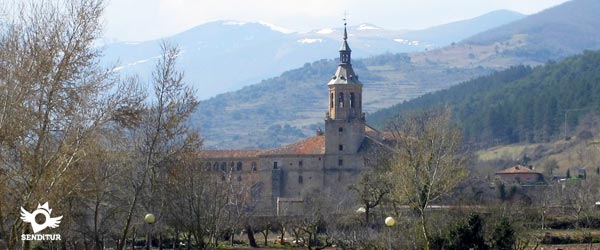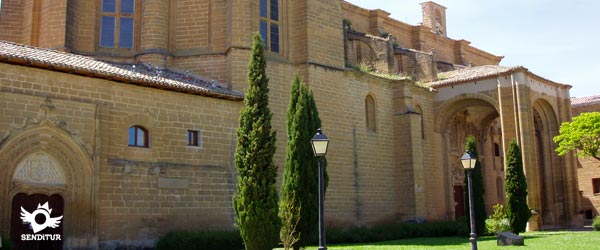
La Rioja, rich in wine tourism, also offers us other significant charms that form part of the great variety of alternatives that this land offers us. Between the wide valley and the high mountains of the sierra, we find the Route of the Monasteries of La Rioja Alta that will take us to know these historical places full of culture and traditions, whose strategic locations will undoubtedly not leave us indifferent.
A whole walk through the history of this region where we will discover from the first words written in Castilian language to pantheons of yesteryear of the powerful kings who inhabited these lands.

The starting point of this route by car is in the town of Nájera, cradle of illustrious kings and seat for years of the court of the kingdom of Navarre. An obligatory stop on the French Way of Saint James, its regal history and its link to the Jacobean route have clearly marked its character, resulting in a rich historical site where the Monastery of Santa María la Real should be highlighted. The visit will take us back in time as we walk through the cloister after passing through the door of the Kings or we get lost in its church discovering the monarchs who found burial in the Pantheon of the Kings.


After enjoying all that Nájera has to offer, the route takes us from this historic town to Anguiano, following the road that joins both municipalities and that would also help us to reach San Millán de la Cogolla, to which we will not go for now. Baños de Río Tobía, known for its meat and wood industries, is the prelude to our arrival at Bobadilla. From here the Najerilla River will now be our travel companion accompanying us to Anguiano and its three neighborhoods, embedded between mountains of vertical walls. This town has deep-rooted traditions such as the Anguiano Dancers or the Anguiano bean festival, where we can enjoy one of the magnificent products that take place here. El Najerilla, after crossing Anguiano, continues to guide us on our way to Valvanera, although we will be forced to say goodbye to it in order to ascend to the Monastery of Valvanera, patron saint of La Rioja. The monastery, destination of numerous pilgrimage routes followed for years by the devotees of the Virgin, is situated in a spectacular spot that gives it a special beauty and calm calm. A good number of people walk here every year from Logroño in what is known as the Valvanerada, a march which, normally in April, covers the 64 kilometres that separate Logroño from Valvanera on foot.


After enjoying the monastery and the spectacular environment that surrounds it we must resume the path and returning on our steps, return to Bobadilla. Just before arriving at this locality we will turn aside to follow the road that crosses the borders of the Mountain range of the Demand and will make us pass next to localities like Villaverde de Rioja or Estollo to leave us to the outskirts of San Millán de la Cogolla. The route makes us cross the village from side to side, following its main street that takes us directly to the Monastery of Yuso, which together with that of Suso, form the Monastery of San Millán. The imposing Sierra de La Demanda, with the unmistakable San Lorenzo at its head, continues to be, for now, the natural environment that surrounds our route, contributing a special beauty to the already high landscape value of this route. The Monastery of Yuso, also known by the nickname of the Escorial de La Rioja, which rises above the remains of the old Romanesque monastery, offers us important treasures not only architectural but also cultural. Not only do the relics of San Millán and San Felices rest there, but we can also find the Library of Codices and Cantorals that include an exceptional Linguistic Heritage, such as the Glosas Emilianenses. During the months of August there are night visits to the monastery where we will be enveloped by the special atmosphere that the night creates around us.


From the monastery below, that of Yuso, there is a bus that will take us to visit the Monastery of Suso, the one above, which awaits us on the slope of the mountain. To get there we can do it either by bus or by walking a short path up to its very door. The ancient caves where San Millán and his disciples lived were gradually giving rise to this temple that now houses the sepulchres of the Seven Infants of Lara. In it was carried out the day to day of the monks, monks like Gonzalo de Berceo who wrote the first verses in Spanish. A true architectural jewel surrounded by a unique environment that increases its special beauty and that makes us go back to past centuries to imagine the then normal and daily events that were lived here and then admire the imprint and trace they left.


Having finished our journey through the Monasteries of Suso and Yuso, we take up again the march that takes us directly to the crossroads with the road that arrives here from Berceo, birthplace of San Millán, and towards where we will go to, after crossing it, follow the path that separates us from Cañas, birthplace of Santo Domingo de Silos. In Cañas we find the Monastery of Santa María of the Salvador, also known as the Monastery of the Light, due to the special luminosity that its interior has and that owes in part to its orientation and alabaster of its stained glass windows. In this monastery live the Cistercian nuns of the order of San Bernardo, one of the first female communities of the Cistercian that were created in the peninsula. It is visited together with those of Yuso and Suso by a good number of pilgrims who deviate from the nearby French Way to contemplate these places.


From Cañas we head towards Santo Domingo de la Calzada following the road that leads us to Alesanco, which, according to one of the two birth certificates that exists, was the birthplace of the Marques de la Ensenada. Crossing this locality, following the course of the road, we will reach Azofra, whose parish hostel has a stone belonging to the Cathedral of Colonia in Germany, to join from there with the highway of the Way that leads us to the next stop. Santo Domingo de la Calzada, which grew up on the old site created here by the illustrious saint, houses, as could not be less given its great history, a rich artistic heritage, including the Monastery of Nuestra Señora de la Asunción, whose special relationship with the Jacobean route is evident in its pilgrims' hostel. Open by appointment to visitors in July, August and September.


With the Sierra de la Demanda already far behind us, we undertake the path from Santo Domingo de la Calzada to Casalarreina following the course marked by the course of the river Oja in its course towards the wide valley of the Ebro. The steep Sierra of the Toloño marks the limits of this fertile valley contributing to it in part the special climate propitious for its magnificent wines. Casalarreina is home to the Monastery of Our Lady of the Piedad, inhabited by Contemplative Dominican cloistered nuns and boasts the important privilege of being the first place in the Iberian Peninsula to be consecrated by a Pope, Adrian VI. The schedule of the visits varies according to the time of the year, the summer months the visits are from Monday to Sunday, at 17:00, 18:00, 19:00 and 19:30 h.

1-Spend some time enjoying the natural surroundings of some of these monasteries, as well as getting to know the localities where they are located. The Sierra de la Demanda offers exceptional scenery and in both the Monastery of Valvanera and San Millán you will be able to take short routes that will immerse you in nature.
2-If you divide the tour into two days you can make the night visit to the Monastery of Yuso, which takes place every August.
3-This region is known worldwide for its wines and there you will even find centenary wineries.
4-Do not miss the cathedral of Santo Domingo de la Calzada, whose tower is separate, forming a separate building.
Map of the route
This map is a sketch made as an example of the route, in no case represents the best or the only itinerary to follow. Its development has not taken into account the current rules of circulation or the state of the places through which it passes and that could affect its layout.
Find out what to see in...
¿Did you know that...
The Monastery of San Millán de la Cogolla is part of the Language Way along with the Monastery of Santo Domingo de Silos and other places of special interest in the rich history of the evolution of Spanish.
Don't miss out...
The visit to the hermitage of San Felices de Bilibio in Haro, from where you can enjoy unbeatable views of the Ebro valley thanks to its privileged location at the top of the Riscos de Bilibio.
![]()
Distance of the route
109 Km We can divide the route in two days to make the most of each place.
![]()
Duration of the visits
6h 30min, is the approximate time that it will take us to carry out the visits, without counting the displacements between each place.
![]()
Time of year
All year round, although autumn offers a varied symphony of ochres and reds, both in the mountains and in the vineyards.
![]()
Charm
Historical-artistic and landscape, to the rich cultural patrimony we have to add the magnificent landscapes that surround us in the route.
From the commitment of SENDITUR with Nature and the respect to the balance of the environment, SENDITUR urges you to travel in a responsible way, with low environmental impact and respecting at all times the Natural, Cultural and Social environment wherever you go.
Besides sharing with all of us your experience on the route we would be grateful if you could write to us to inform us of any erroneous or outdated information you may have found, or simply to let us know what you think at Thank you.
Route information updated on 10-04-2019. The route may vary greatly depending on the time of year, weather conditions and terrain, as well as the actions of third parties and the evolution suffered in the natural environment where it is located. All opinions, advice and/or assessments made by SENDITUR in their descriptions are for guidance only and are subject to and/or refer to the specific conditions of the specific day of the route, referring to that specific day, taken from trained people, with the appropriate experience and with a high level of physical and technical preparation as a reference, as well as correctly equipped.
All the times are approximate and take an orientative character, the stops have not been taken into account, no matter how small they are. All the information related to the route, texts, images, videos, maps, diagrams, tracks, towns, and places of tourist interest are published as a guide, and may not coincide with the current state of each place. Before undertaking any activity, assess your technical knowledge, your physical condition, find out about the weather and the variations that the route may undergo, equip yourself correctly, be prudent and responsible at all times, and do not exceed your capabilities. SENDITUR is not responsible for any misuse or inappropriate use of the comprehensive guides of its routes and/or publications as well as its electronic guides, nor for any variations in their descriptions for the aforementioned reasons, and recommends that everyone be responsible and prudent in carrying out the activity. We also encourage you to read books and specialised guides to complement the information described above.
Continue watching …